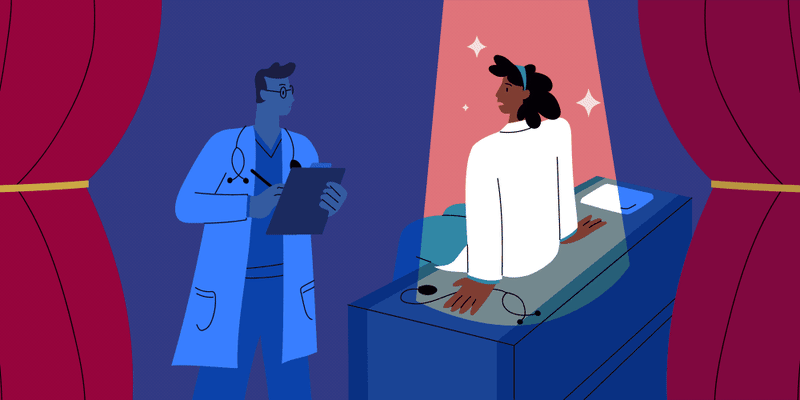 In response to increasing administrative burdens and cumbersome charting levied upon healthcare providers in recent years, medical scribes have been touted as a potential solution for streamlining the documentation process. Interest in the use of scribes has certainly been increasing; the American College of Medical Scribe Specialists estimates that the number of medical scribes nationally will increase from 15,000 in 2014 to more than 100,000 by 2020.
In response to increasing administrative burdens and cumbersome charting levied upon healthcare providers in recent years, medical scribes have been touted as a potential solution for streamlining the documentation process. Interest in the use of scribes has certainly been increasing; the American College of Medical Scribe Specialists estimates that the number of medical scribes nationally will increase from 15,000 in 2014 to more than 100,000 by 2020.
Who are medical scribes?
Medical scribes are often college students looking to gain exposure to the medical field, many of whom are planning on applying to medical or physician assistant (PA) school in the future. There are also those who work full time as medical scribes. The salary of a medical scribe ranges from $13-18 per hour and the cost to hire a scribe is around $20 per hour. While there are courses and certifications dedicated to medical scribing, medical scribes are not required to go through a certification process.
The precise role of the medical scribe will vary by institution, but they generally perform a variety of tasks with the goal of maximizing the provider’s workflow efficiency. In addition to transcribing medical charts, scribes may also obtain prior records, notify providers of lab and imaging studies results, and prepare discharge instructions.
A new twist to the medical scribe paradigm is the implementation of virtual scribes. A virtual medical scribe remotely accompanies the physician during a patient interaction, documenting the encounter in the electronic medical records (EMRs) off-site.
Benefits
The most obvious purported benefit to working with a scribe is increased productivity. By minimizing the time spent on documentation and other secretarial tasks, providers can focus on patient care. One retrospective study found that the use of scribes by emergency physicians was associated with improved overall productivity, as measured by patients treated per hour and relative value units (RVUs) generated per hour. A prospective cohort study at a tertiary academic emergency department (ED), published in 2017, found that scribes enabled attending physicians to see more patients per hour, though they did not improve overall patient throughput. In the primary care setting, the use of medical scribes has been associated with significant reductions in electronic health record documentation time and significant improvements in productivity.
Other benefits associated with using scribes, as reported by physicians who have worked with them, include: better patient interactions, improved physician satisfaction, and potential mitigation of physician burnout. Some providers feel that the quality of the patient encounter is improved by allowing the provider to focus more on the patient interaction than the data entry.
Downsides
The costs associated with implementing a scribe program, or hiring an independent scribe, are significant. In addition to the scribe’s salary, other expenses may include those associated with training, hardware, and technology support. That said, proponents of medical scribes argue that the increased productivity that results from the use of scribes off-sets these costs.
From my personal experience working with scribes, I think the biggest downsides are the variability in the quality of scribes and rapid turnover. I found that it takes time for a particular scribe to understand how I structure my workflow and how to best document my charts. Our working dynamic would steadily improve … right up until they left for medical school. Then, a new batch of scribes would come in and the process would have to start all over again. When working with an inexperienced scribe, I would often need to spend so much time modifying the chart to fit my documentation style—or making corrections—that I would have been better off documenting the chart on my own from the beginning.
Moreover, having an additional person in the room during the history and physical also has the potential to negatively impact the provider-patient interaction. It may even affect the accuracy of the history obtained. I can certainly imagine a scenario wherein a young male would be less willing to discuss his penile discharge when a college-aged female is at the bedside transcribing the history (versus if only the physician were present). Patients are often in a very vulnerable position when presenting to an ED or clinic. It’s imperative that we try our best to create an environment that allows patients to speak comfortably about the most intimate details of their lives. Obviously, adding another person to the mix may hinder this. While I have had patients tell me that they would prefer to be seen without the scribe present, many patients may not be comfortable making such a request.
The Upshot
To answer the question posed: Are medical scribes the solution to our documentation woes?—I would have to say: no. I’ve had great experiences working with scribes and have seen first-hand their ability to recoup documentation time and streamline the charting process. However, a solution that requires every physician to have another person following them on their shift, whether it’s in-person or remotely, is not truly a solution. Rather, it is a stop-gap measure that does nothing to address the underlying problems, inefficient EMRs and burdensome compliance measures.
The real solution will be the development of an EMR that is built with a focus on clinician usability (without sacrificing the ability to capture revenue). With the advent of advanced speech recognition technology and artificial intelligence, both of which promise to simplify the way we interact with our devices, I’m hopeful that such a system is on the horizon.
Image by PhotoSmileBeautiful / Shutterstock
EfficientMD is an Emergency Medicine physician who blogs about physician efficiency and productivity. You can read more of his content at EfficientMD.






